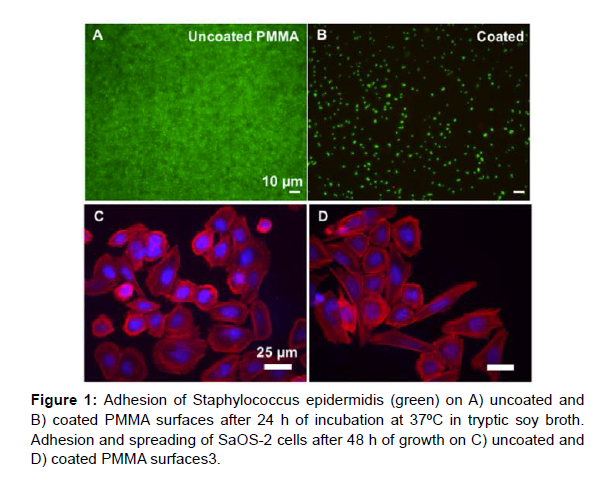Race for the Surface: Simultaneous Growth of Bacteria and Mammalian Cells on DNA Polyelectrolyte Multilayer Coatings
Received: 01-Oct-2022 / Manuscript No. jpmm-22-330 / Editor assigned: 04-Oct-2022 / PreQC No. jpmm-22-330 (PQ) / Reviewed: 18-Oct-2022 / QC No. jpmm-22-330 / Revised: 25-Oct-2022 / Manuscript No. jpmm-22-330 (R) / Published Date: 31-Oct-2022
Abstract
We introduce a dip-and-rinse, DNA-based coating to reduce the risk of bacterial infection and promote tissue tegration of implants, applicable to most common implant surfaces. Medical implants are used to restore the function of failed body parts, but their application is limited by implant-associated infections (IAI). IAI yield high mortality because bacteria that colonize implant surfaces form a biofilm, which protects them against immune cells and antibiotics1. In most cases, the final outcome of IAI is the removal of the infected implant from the body [1]. Bacterial contamination of implants frequently happens during the surgery (peri-operative contamination). Whether this contamination develops into an infection or not depends mainly on the outcome of the so-called ‘race for the surface’ between successful tissue integration of the implant and colonization of the surface by bacteria2. Bacterial attachment to the implant surface is the initial step of biofilm formation, and therefore a preventative strategy is to use antiadhesive coatings. However, truly antiadhesive coatings not only decrease bacterial colonization but also host tissue integration. The ultimate solution is therefore multifunctional coatings that are non-adhesive to microbes and simultaneously support tissue integration [2]. We hypothesized that polyanionic DNA could prevent bacterial adhesion and biofilm formation. In our recent study, we produced DNA coatings via the facile layer-by-layer technique alternating DNA with the biocompatible biopolymer chitosan. We showed that the LbL DNA coatings significantly reduced the adhesion of Staphylococcus and Pseudomonas to both PMMA and titanium implant surfaces. In addition, our DNA coatings demonstrated no cytotoxicity when cultured with SaOS-2 cells3 (Figure 1). Here, we continue to investigate the simultaneous growth of bacteria and mammalian cells on the DNA polyelectrolyte multilayer coated implant surface based on the race for the surface [3].
Biography
Guruprakash Subbiahdoss is affiliated to the Institute of Biologically Inspired Materials, Department of Nanobiotechnology, University of Natural Resources and Life Sciences (BOKU) Vienna, Austria. His research interests reflect in his wide range of publications in various national and international journals.
References
- Costerton JW (1999) Introduction to biofilm. Int J Antimicrob Ag 11: 217-221.
- Gristina AG (1987) Biomaterial-Centered Infection - Microbial Adhesion Versus Tissue Integration. Science 237: 1588-1595.
- Ouni OA, Subbiahdoss G, Scheberl A, Reimhult E (2021) DNA polyelectrolyte multilayer coatings are antifouling and promote mammalian cell adhesion. Materials 14: 4596.
Citation: Subbiahdoss G, Reimhult E (2022) Race for the Surface: Simultaneous Growth of Bacteria and Mammalian Cells on DNA Polyelectrolyte Multilayer Coatings. J Powder Metall Min 6: 330.
Copyright: © 2022 Subbiahdoss G, et al. This is an open-access article distributedunder the terms of the Creative Commons Attribution License, which permitsunrestricted use, distribution, and reproduction in any medium, provided theoriginal author and source are credited.
Share This Article
Recommended Journals
Open Access Journals
Article Usage
- Total views: 1094
- [From(publication date): 0-2022 - Apr 04, 2025]
- Breakdown by view type
- HTML page views: 753
- PDF downloads: 341

